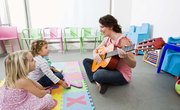Integrating curriculum in the classroom includes combining different subject areas and then teaching them in relation to a singular theme or an idea. Innovative teachers and schools prefer integrating the curriculum in their classrooms as it improves student achievement and leads to an increase in student standardized scores. Student achievement being the primary focus, an integrated curriculum utilizes three different types of approaches of integration including the multidisciplinary approach, the interdisciplinary approach and the transdisciplinary approach.
Use the multidisciplinary integration approach by organizing a list of standards from various disciplines around one common theme. For instance integrate a list of standards from disciplines such as history, geography, economics, and government to focus on a common intradisciplinary social studies program. Another method of the multidisciplinary approach involves fusing skills, knowledge and attitudes into the school curriculum. For instance, teachers can utilize technology across the curriculum with the use of computer technology integrated into every subject area. In this way students learn their various subjects and enhance their computer skills. Additionally, schools also utilize service learning projects and integrate the service learning into the classroom. For instance by preparing and passing out brochures for farm workers (in multiple languages) about the pros and cons of pesticides, students can complete the learning standards for various subjects including science, social studies and language arts.
Use the interdisciplinary integration approach by organizing the curriculum around common learning across the various different disciplines. For instance focus on common learning or specific interdisciplinary skills such as thinking skills, comprehension, and research skills when teaching science, english, history, and geography. The idea is to learn skills and concepts through the lesson that are beyond the immediate lesson. An integrated program such as Learning Through the Arts, teaches students math and science concepts and skills through activities such as singing, sculpting, painting, and dancing.
Use the transdisciplinary integration approach by organizing the curriculum around student questions and concerns. Transdisciplinary integration is done through project-based learning which involves allowing the students to tackle a problem. Project-based learning allows students to make connections among different subjects by solving the problem and answering open-ended questions. Transdisciplinary integration is also done by negotiating the curriculum which utilizes student questions for the basis for the curriculum. Themes that students have developed in different schools include examples such as Medical Issues Affecting Our Lives and Violence in Our Culture. Learning how to solve problems and asking questions enables the students with skills that can later be applied towards real-life problems.
Related Articles
References
Writer Bio
Based in California, Taruna Chhabra has been writing general knowledge and science-related articles for various websites since 2010. Chhabra holds a Master of Public Administration and a Bachelor of Science in biology from the University of San Francisco.











